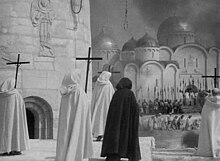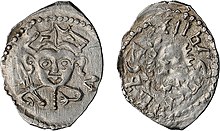Pskov Republic
Pskov Republic Псковская республика | |||||||||
|---|---|---|---|---|---|---|---|---|---|
| 1348–1510 | |||||||||
 Pskov Republic in 1400 | |||||||||
| Capital | Pskov | ||||||||
| Common languages | Russian | ||||||||
| Religion | Russian Orthodoxy | ||||||||
| Demonym(s) | Pskovian | ||||||||
| Government | Mixed | ||||||||
| History | |||||||||
• Established | 1348 | ||||||||
| 1348 | |||||||||
| 1399 | |||||||||
| 1510 | |||||||||
| |||||||||
| Today part of | Estonia Russia | ||||||||
ThePskov Republic(Russian:Псковская республика,romanized:Pskovskaya respublika) was a medieval state innorthern Russia.Originally a principality and then a part of theNovgorod Republic,Pskov became an independent republic in 1348. Its territory was roughly equivalent to modern-dayPskov Oblast.Its capital city wasPskov.
History[edit]
Origins[edit]
As a principality, Pleskov (old name of Pskov) was ruled by separate princes, but often it was ruled directly from Novgorod until the mid-13th century when the city began accepting as rulers princes exiled from their possessions. Each exiled prince that went to Pleskov could be proclaimed prince there (if the principal throne wasn't already occupied by another prince). In any case, he could at least get an honorary reception and live there without fear for his life.
After the disintegration ofKievan Rus'in the 12th century, the city ofPskovwith its surrounding territories along theVelikaya River,Lake Peipus,Pskovskoye LakeandNarva Riverbecame part of theNovgorod Republic.It kept its special autonomous rights, including the right for independent construction of suburbs (Izborskis the most ancient among them). Due to Pskov's leading role in the struggle against theLivonian Order,its influence spread significantly. The long reign ofDaumantas(1266–99) and especially his victory in theBattle of Rakvere(1268) ushered in the period of Pskov's actual independence. The Novgorodboyarsformally recognized Pskov's independence in theTreaty of Bolotovo(1348), relinquishing their right to appoint theposadniksof Pskov.
Relationship with Lithuania and Moscow[edit]
For the most of 14th century, and especially after separating from Novgorod, Pskov was in the sphere of influence of theGrand Duchy of Lithuania.This changed after Grand DukeVytautasof Lithuania signed theTreaty of Salynaswith theLivonian Order,promising to help the Order with conquering Pskov in exchange for the Order's support elsewhere. Prince Ivan Andreyevich left the city and Pskov sent emissaries to Grand DukeVasily I of Moscowasking for one of his vassal rulers to be the new prince of Pskov. It remained dependent on Moscow until the end of the Pskov Republic in 1510, helping Moscow in its conflicts with Lithuania and Novgorod.[1]
Final years[edit]

In 1501, the armies of Pskov and Moscow were defeated in theBattle of the Siritsa Riverby theLivonian Order,but the city withstood a subsequent siege.
In 1510, the Grand Prince of MoscowVasili IIIarrived in Pskov and pronounced it hisvotchina,thus putting an end to the Pskov Republic and its autonomous rights. The city's ruling body, the veche, was dissolved and some 300 families of rich Pskovians were deported from the city. Their estates were distributed among the Muscoviteservice class people.From that time on, the city of Pskov and the lands around it continued to develop as a part of the centralized Russian state, preserving some of its economic and cultural traditions.
Internal organization[edit]

The Pskov Republic had well-developedfarming,fishing,blacksmithing,jewellery-making and construction industries. Exchange of commodities within the republic itself and itstradewith Novgorod and other Russian cities, theBaltic region,andWestern Europecities made Pskov one of the biggesthandicraftand trade centres of Rus'. As opposed to the Novgorod Republic, Pskov never had big feudallandowners:estateswere smaller and even more scattered than of those in Novgorod.[2]The estates of Pskovian monasteries and churches were much smaller as well. Some land was owned bysmerdswhile otherizornikidid not own the land they worked and were obliged to pay rent – between a quarter and a half of the harvest. A farmer who had no debts to his landlord could leave him only on a certain day of the year.[3][4]

The government of the Pskov Republic consisted of theveche(popular assembly),posadnichestvo(mayoralty) and the prince (directly or through a viceroy). Mayors (posadniki) from all parts of the city, together with one or more Lord Mayors and former mayors formed the Council of Lords (sovet gospod, boyarskiy sovet) which was the main executive organ of the state. The offices of mayors (posadniki) became a privilege of several noble (boyar) families.[5]
The veche had legislative powers, it could appoint military commanders and hear ambassadors' reports. It also approved expenses such as grants to princes and payments to builders of walls, towers and bridges.[6]Veche gathered at theTrinity Cathedral,which held the archives of the veche and important private papers and state documents. The veche assembly included posadniks, "middle" and common people.[7]The historians differ on the extent to which the veche was dominated by the elites, with some saying that the real power was in the hands of boyars and others considering veche a democratic institution.[8]

Conflicts were common and the confrontation between the veche and the posadniks in 1483–1484 led to the execution of one posadnik and to the confiscation of property of three other posadniks who fled to Moscow.[9]The power of the prince was limited but – in contrast to the Novgorod Republic – he still retained important administrative and judicial functions, the latter carried out jointly with the posadnik.[10][11]The socio-economic and political life of the Pskovian land were reflected in theLegal Code of Pskov.
Pskov was divided into several parts, called ends (kontsy). There were four ends in the 14th century, as the city was growing and a new wall was constructed in 1465 the new ends were created. Each end had its central church which housed the archive, treasury andrefectorywhere holiday feasts were held. The ends played a prominent role in the government: often delegations sent by Pskov had representatives from all the ends and each end administered a part of the territory of the republic outside of the capital city.[12]
Pskov remained dependent on Novgorod inecclesiasticall matters during the republican period. A religious sect whose followers were known as thestrigolnikiwas active in the city in the second half of the 14th century and the beginning of the 15th century.
Trade and economy[edit]

Pskov, along withNovgorod,was an important centre of trade betweenRussiaandWestern Europe.Already in the 13th century German merchants were present in theZapskovyearea of Pskov and theHanseatic Leaguehad atrading postin the same area in the first half of the 16th century which moved toZavelichyeafter a fire in 1562.[13][14]Pskov's main trade partners wereRiga,RevalandDorpat.[15]The wars withLivonian Order, Poland-LithuaniaandSwedeninterrupted the trade but it was maintained until the 17th century, with Swedish merchants gaining the upper hand eventually.[14]
Culture[edit]

Pskov churches feature many distinctive elements:corbel arches,churchporches,exterior galleries andzvonnitsabell towers. These features were introduced by Pskov masons toMuscovy,where they constructed numerous buildings during the 15th and 16th centuries. Out of all non-religious construction, only the fortresses inPskov,IzborskandGdovhave survived.

The literature of Pskov land was an integral part of themedieval Russian literature[broken anchor].The chronicle-writing started in the 13th century, at first dealing mostly with topics of local interest. By the 15th century, the chronicles became more detailed and described events in Muscovy, Novgorod, Lithuania and the Golden Horde. The most important works written in Pskov are theStory ofDovmontdescribing the coming of Dovmont to the city, his baptism and subsequent victories,The Life ofSaint EuphrosynusandThe Address ofHegumenPamfilwhich contains one of the earliest descriptions ofIvan Kupalarituals.[16]
The downfall of Pskov is recounted in theStory of the Taking of Pskov(1510), which was lauded byD. S. Mirskyas "one of the most beautiful short stories of Old Russia. The history of the Muscovites' leisurely perseverance is told with admirable simplicity and art. An atmosphere of descending gloom pervades the whole narrative: all is useless, and whatever the Pskovites can do, the Muscovite cat will take its time and eat the mouse when and how it pleases".[17]
List of princes[edit]
- 1342–1349Andrei of Polotsk(Gedeminids)
- 1349–1360 Eustaphy Feodorovich (Prince of Izborsk)
- 1360–1369 Alexander of Polotsk
- 1375–1377 Matvei
- 1377–1399Andrei of Polotsk
- 1386–1394 Ivan Andreyevich
- 1399–1510 viceroys of theGrand Duchy of Moscow
References[edit]
- ^Arakcheev, Vladimir (2004).Средневековый Псков. Власть, общество, повседневная жизнь в XV—XVII веках(in Russian). Псков. pp. 10, 40.ISBN5945421073.
- ^Масленникова, Н. Н. (1978).Псковская земля // Аграрная история Северо-Запада России XVI века.Leningrad: Nauka.
- ^Kafengauz, Berngardt (1969).Древний Псков. Очерки по истории феодальной республики(in Russian). Nauka. p. 133.
- ^Arakcheev, Vladimir (2004).Средневековый Псков. Власть, общество, повседневная жизнь в XV—XVII веках(in Russian). Псков. pp. 63–78.ISBN5945421073.
- ^Kafengauz, Berngardt (1969).Древний Псков. Очерки по истории феодальной республики(in Russian). Nauka. pp. 46, 51, 52.
- ^Kafengauz, Berngardt (1969).Древний Псков. Очерки по истории феодальной республики(in Russian). Nauka. pp. 98–105.
- ^Kafengauz, Berngardt (1969).Древний Псков. Очерки по истории феодальной республики(in Russian). Nauka. p. 111.
- ^Kafengauz, Berngardt (1969).Древний Псков. Очерки по истории феодальной республики(in Russian). Nauka. pp. 85–90, 110.
- ^Kafengauz, Berngardt (1969).Древний Псков. Очерки по истории феодальной республики(in Russian). Nauka. p. 74.
- ^Lawrence Langer, "The Posadnichestvo of Pskov: Some Aspects of Urban Administration in Medieval Russia.”Slavic Review43, no. 1 (1984): 46–62.
- ^Arakcheev, Vladimir (2004).Средневековый Псков. Власть, общество, повседневная жизнь в XV—XVII веках(in Russian). Псков. pp. 58–60.ISBN5945421073.
- ^Arakcheev, Vladimir (2004).Средневековый Псков. Власть, общество, повседневная жизнь в XV—XVII веках(in Russian). Псков. pp. 13–15.ISBN5945421073.
- ^Dollinger, Philippe(1999).The German Hansa.Psychology Press. p. 105.ISBN9780415190732.
- ^abАракчеев владимир Анатольевич,Псков и Ганза в эпоху средневековья,ООО "Дизайн экспресс", 2012(in Russian)
- ^Arakcheev, Vladimir (2004).Средневековый Псков. Власть, общество, повседневная жизнь в XV—XVII веках(in Russian). Псков. pp. 22–23.ISBN5945421073.
- ^Централизованная библиотечная система города Пскова,Литература Древнего Пскова(in Russian)
- ^D. S. Mirsky.A History of Russian Literature.Northwestern University Press, 1999.ISBN0-8101-1679-0.Page 23.
Sources[edit]
- Масленникова Н. Н.Присоединения Пскова к Русскому централизованному государству.Leningrad, 1955.
Further reading[edit]
- The Chronicles of Pskov, vol. 1–2. Moscow–Leningrad, 1941–55.
- Валеров А. В.Новгород и Псков: Очерки политической истории Северо-Западной Руси XI—XIV вв.Moscow: Aleteia, 2004.ISBN5-89329-668-0.



